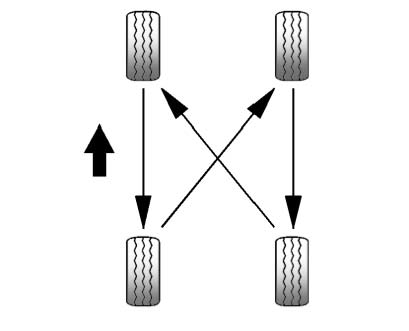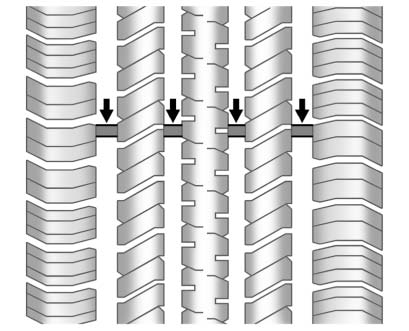Buick Enclave: Tire Inspection. Tire Rotation. When It Is Time for New Tires
We recommend that the tires, including the spare tire, if the vehicle has one,
be inspected for signs of wear or damage at least once a month. Replace the tire if: Tires should be rotated every 12 000 km (7,500 mi). See Maintenance Schedule . Tires are rotated to achieve a uniform wear for all tires. The first rotation is the most important. Any time unusual wear is noticed, rotate the tires as soon as possible and check
the wheel alignment. Also check for damaged tires or wheels. See When It Is Time for New Tires and Wheel Replacement . Use this rotation pattern when rotating the tires. If the vehicle has a compact spare tire, do not include it in the tire rotation. Adjust the front and rear tires to the recommended inflation pressure on the
Tire and Loading Information label after the tires have been rotated. See Tire Pressure and Vehicle Load Limits . Reset the Tire Pressure Monitor System. See Tire Pressure Monitor Operation . Check that all wheel nuts are properly tightened. See “Wheel Nut Torque” under
Capacities and Specifications . In an emergency, a cloth or a paper towel can be used; however, use a scraper
or wire brush later to remove all rust or dirt. Lightly coat the center of the wheel hub with wheel bearing grease after a wheel
change or tire rotation to prevent corrosion or rust build-up. Do not get grease on the flat wheel mounting surface or on the wheel nuts or
bolts. Check that the spare tire, if the vehicle has one, is stored properly. Push,
pull, and then try to rotate or turn the tire. If it moves, tighten the cable. See
Tire Changing . Factors such as maintenance, temperatures, driving speeds, vehicle loading, and
road conditions affect the wear rate of the tires. Treadwear indicators are one way to tell when it is time for new tires. Treadwear indicators appear when the tires have only 1.6mm (1/16 in) or less
of tread remaining. See Tire Inspection and Tire Rotation for more information. The rubber in tires ages over time. This also applies for the spare tire, if the vehicle has one, even if it is never
used. Multiple conditions including temperatures, loading conditions, and inflation
pressure maintenance affect how fast aging takes place. Tires will typically need
to be replaced due to wear before they may need to be replaced due to age. Consult
the tire manufacturer for more information on when tires should be replaced. Vehicle Storage Tires age when stored normally mounted on a parked vehicle. Park a vehicle that
will be stored for at least a month in a cool, dry, clean area away from direct
sunlight to slow aging. This area should be free of grease, gasoline, or other substances
that can deteriorate rubber. Parking for an extended period can cause flat spots on the tires that may result
in vibrations while driving. When storing a vehicle for at least a month, remove
the tires or raise the vehicle to reduce the weight from the tires.Tire Inspection
Tire Rotation

 WARNING
WARNING
Rust or dirt on a wheel, or on the parts to which it is fastened, can make wheel
nuts become loose after time. The wheel could come off and cause an accident. When
changing a wheel, remove any rust or dirt from places where the wheel attaches to
the vehicle.When It Is Time for New Tires


